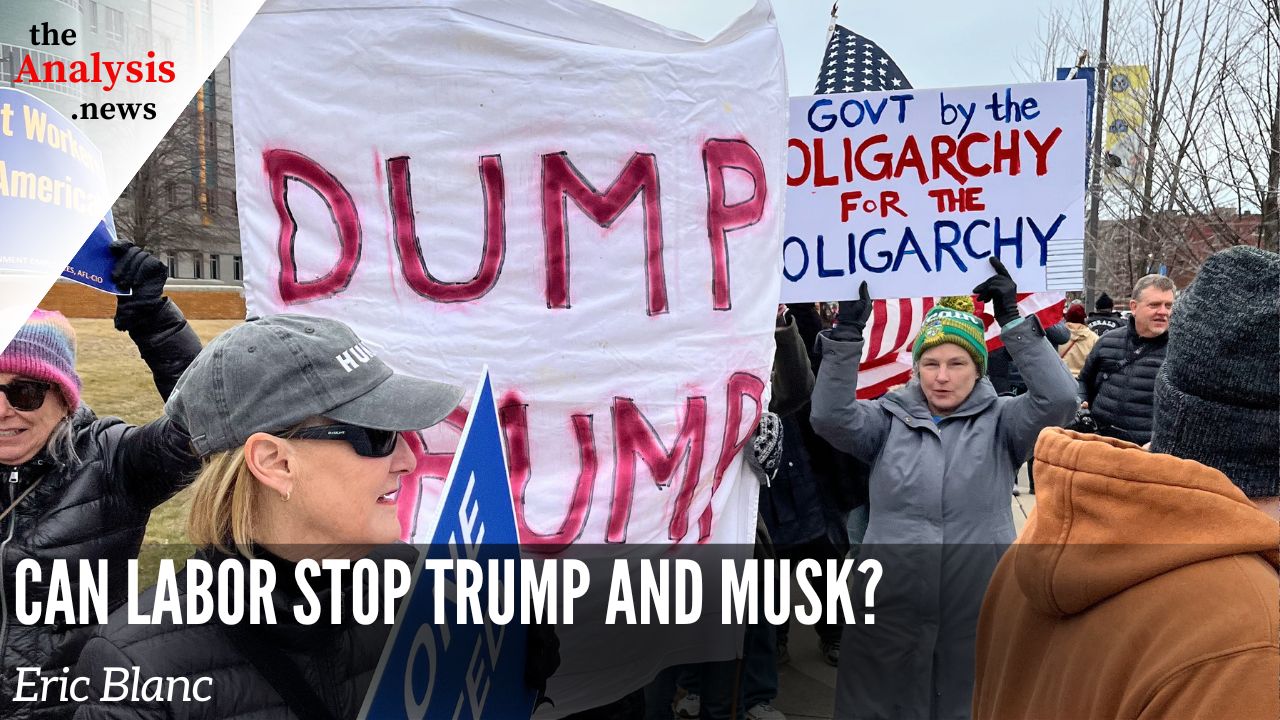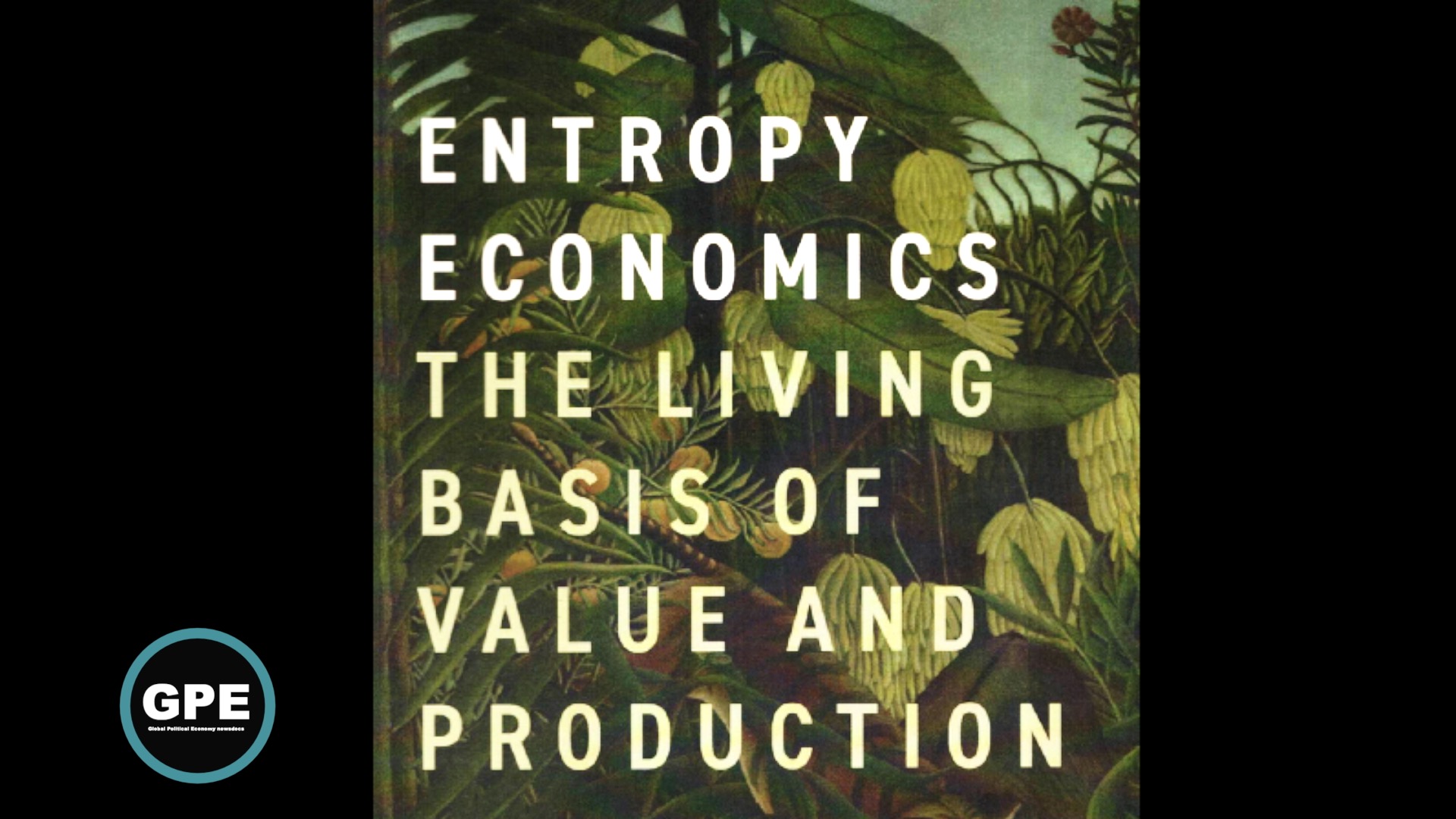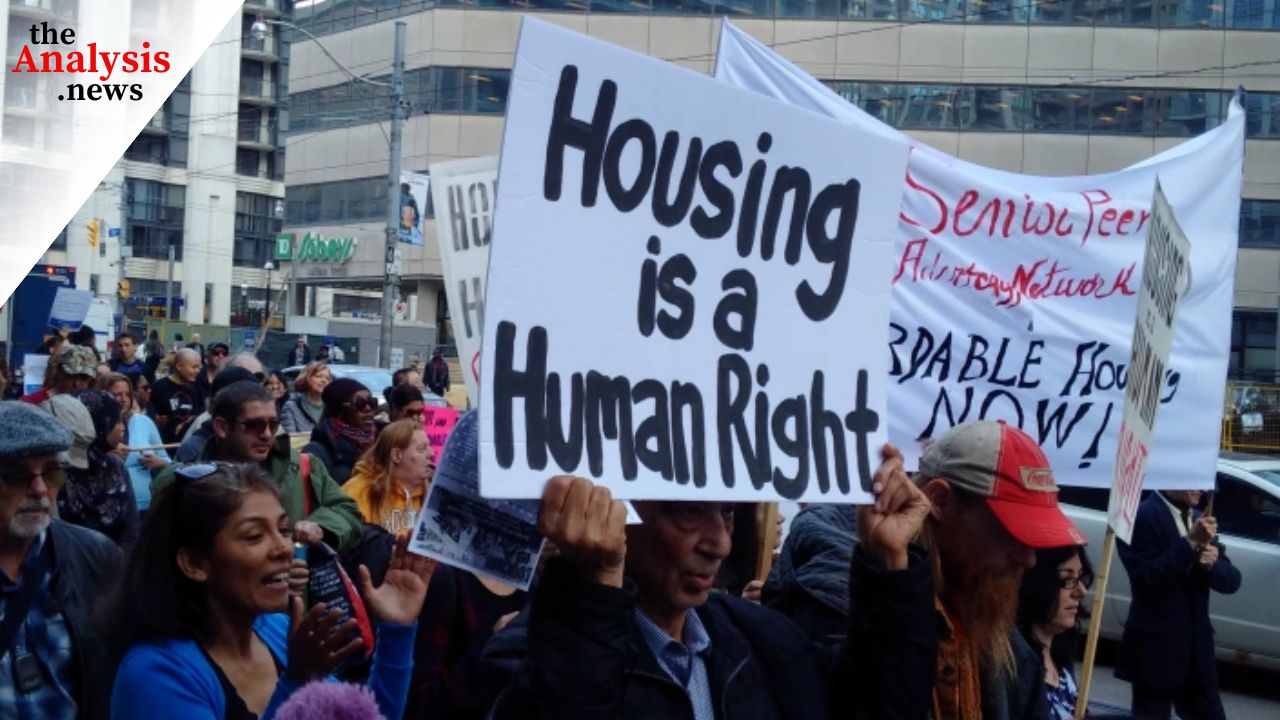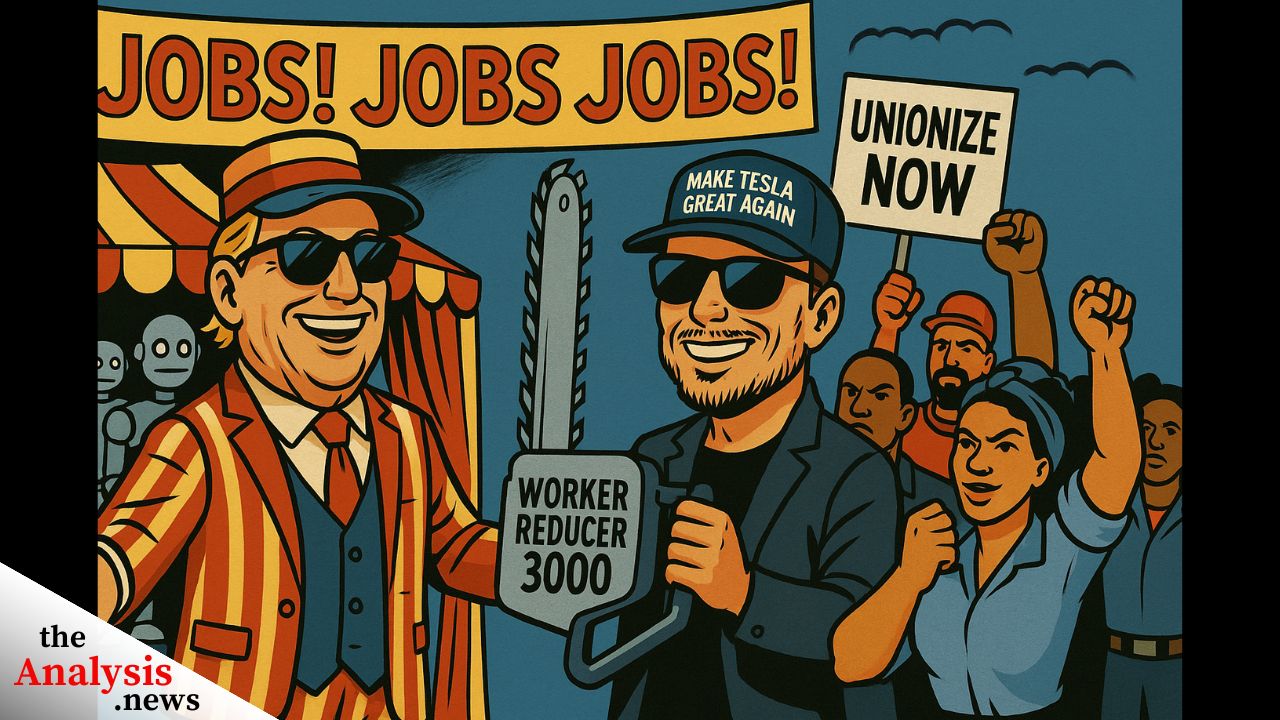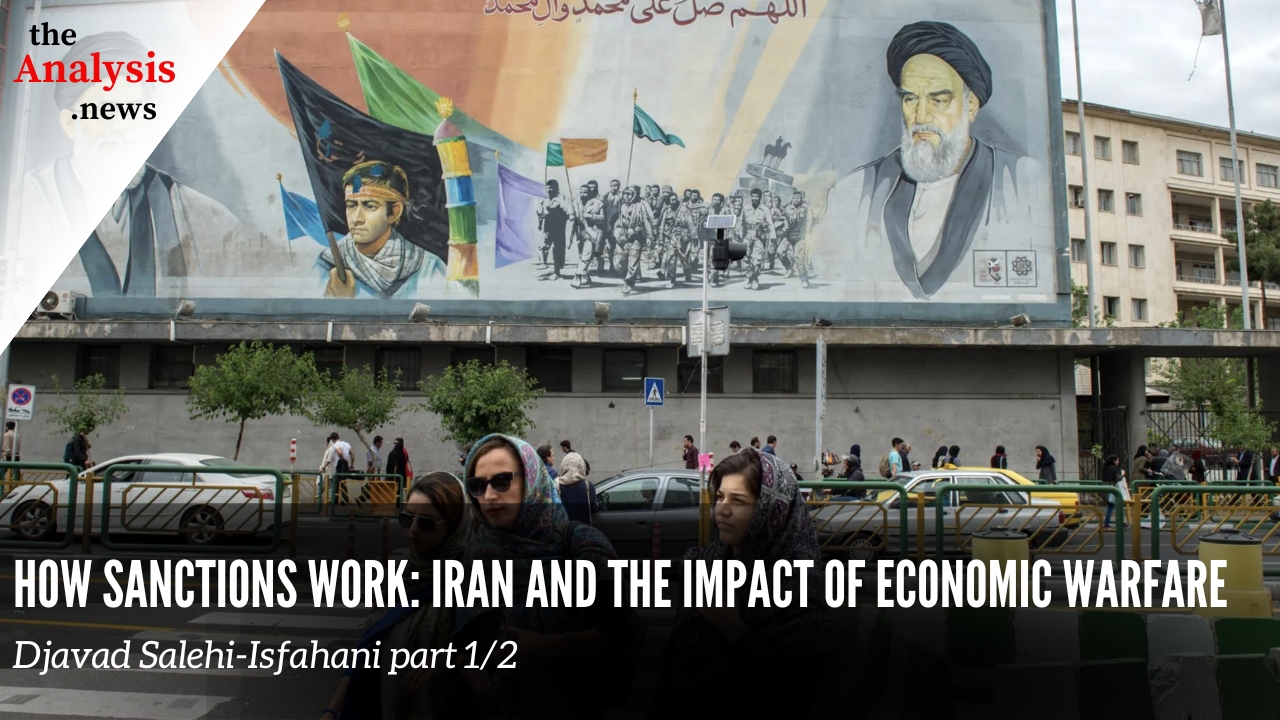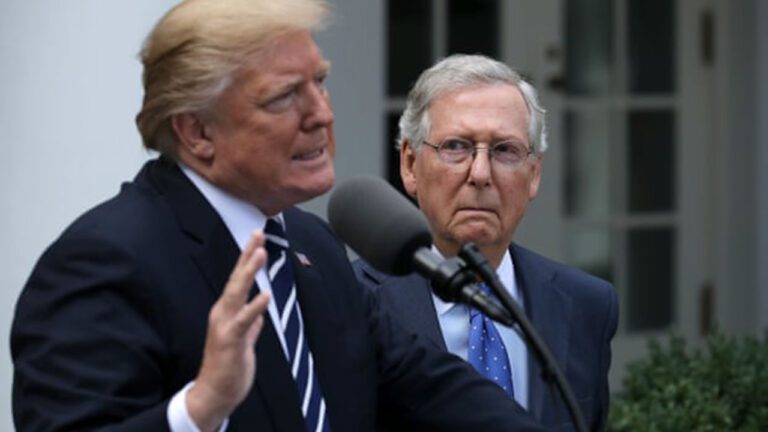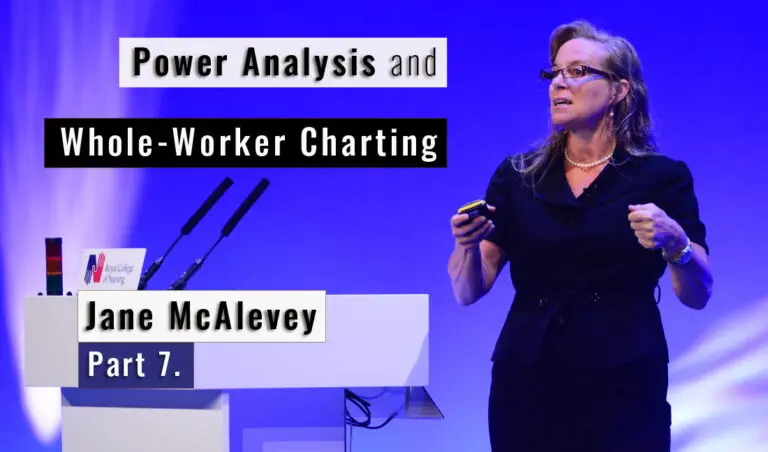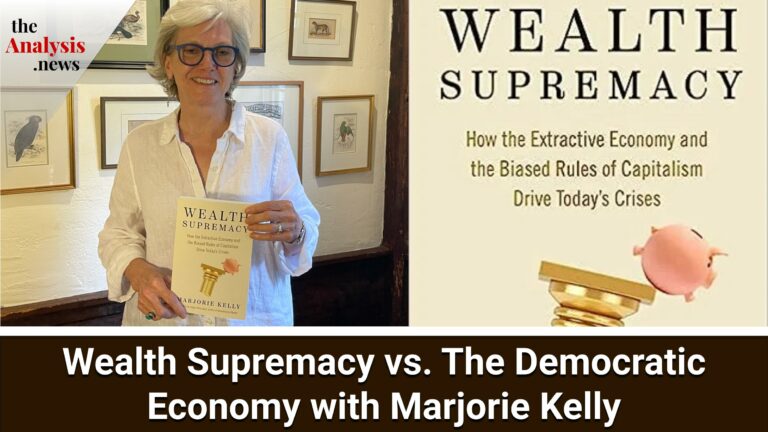On this episode of theAnalysis.news, Frank Hammer speaks with labor scholar and activist Eric Blanc about the growing role of organized workers—especially federal unions—in confronting the Trump-Musk authoritarian agenda. They discuss the resurgence of May Day protests, the push for a general strike in 2028, and the urgent need for mass resistance now, not later.
Blanc outlines how Trump’s attacks on federal unions are a warning shot for the entire labor movement, drawing historical parallels to Reagan’s PATCO firings. He also calls on union leaders, including the AFL-CIO, to move beyond court battles and into coordinated, disruptive action.
Frank Hammer
Hi, I’m Frank Hammer, and welcome to theAnalysis.news. In just a few seconds, I’ll be back with Eric Blanc, and we’re going to talk about the role of labor and federal workers, in particular, in defeating the Trump and Musk coup. Don’t forget the donate button, and I’ll be back in just a second.
Joining me now is Eric Blanc. He is a professor of Labor Studies at Rutgers University. He writes The Labor Politics newsletter on Substack. His latest book is We Are the Union: How Worker-to-Worker Organizing Is Revitalizing Labor and Winning Big. Eric, with that, I welcome you.
Eric Blanc
Yeah. Thanks for having me on.
Frank Hammer
This is a wonderful occasion. It’s the day after May Day, and maybe we might want to start off with that. Were you able to observe any of the May Day events around the country? Were you possibly a participant in one?
Eric Blanc
Yeah, I was at the May Day protest in New York City. Yeah, it was big. It was livelier than the last few years, and I think it speaks to the obvious crisis we’re in, in the U.S., where working people are facing this authoritarian, billionaire takeover. I think the reason you’re seeing so many workers on the streets is a reflection of the crisis we’re in.
Frank Hammer
Did you see any change in the makeup of May Day? Not only was it larger, but did you see greater participation by the labor movement, by the labor unions?
Eric Blanc
Yeah, there was certainly more union participation. The unfortunate tradition in the U.S. is that Labor Day, obviously, got taken away from us, and it got moved to late in the summer. May Day, until recently, oftentimes, just frankly, wasn’t celebrated by unions, and either just the Left would do it, or more recently, immigrant rights groups have revived May Day to their credit. I think that we saw more unions this year, speaking to the increased urgency of resistance.
Frank Hammer
Here in Detroit, we had our May Day event.
Audio Clip
Hundreds of protesters are hitting the streets on this International Workers’ Day, May Day, taking a stand against the Trump administration.
Frank Hammer
I was able to draw on Shawn Fain at the end of his negotiations with the Big Three, establishing the expiration date of the contracts on April 30 in 2028. He began to speak about organizing for a general strike and highlighting May Day.
Shawn Fain
We’re in the middle of two massive transformations. One is in our economic system, where the rules of global trade are being upended and with huge implications for workers everywhere. The other major transformation is in our political system, where fundamental rights are being eroded with huge implications for workers everywhere.
Frank Hammer
Do you think that they may influence more unions to take up this call and maybe begin to establish May Day as the actual worker celebration of solidarity?
Eric Blanc
Yeah, I think part of the reason why we saw more involvement on May Day, specifically, comes out of the call, as you suggest, of Shawn Fain and the UAW for a general strike on May Day in 2028. The Chicago Teachers Union and other progressive unions have taken up that fight to say that if we’re going to be able to get in the direction of something as ambitious as a general strike in 2028, we need to start organizing now. There was a big push by the CTU and allied left-leaning unions to start mobilizing on this May Day.
I think that it’s an important day to reclaim. It’s an important benchmark to see how much capacity we have. I think, frankly, we can’t wait till 2028. I’m glad that there was mobilization this May Day, but I still think the crucial question is, what are we doing over the next four months and not just over the next four years?
Frank Hammer
Indeed. Of course, Fain made that remark before Trump was elected, so I think the urgency escalated shortly after. So you had written in a previous Guardian article that it’s hard to exaggerate the stakes by standing up in large numbers to defend federal workers and their services. We can isolate and eventually defeat Musk and Trump. If we don’t, we could be living with the consequences for a long, long time to come. What does that look like to you? How can you pull that apart and explain how you perceive that?
Eric Blanc
Yeah, the federal workers, as Chris Dols, who’s a leader of the Federal Unionist Network, put it, the canary in the coal mine.
Chris Dols
They’re really not after efficiency. The attacks on probationary employees is making it much, much harder for all of us who remain.
Amy Goodman
Can I just make a clarification on probation? We’re talking about hundreds of thousands of workers, and they can be people who work under two years, but they can also be someone who worked for 30 years, was promoted.
Chris Dols
That’s right.
Eric Blanc
What the government is trying to do to the federal workers is what they’re going to do to the rest of us as working people in other unions if we let them get away with it. Yes, in that sense, it’s really hard to exaggerate the stakes.
The reason they had to go after the federal workers first is that Trump understands that he needs this completely compliant government apparatus at his whim. The main obstacle to that is federal workers’ unions because they’re going to push back against illegal reactionary positions from above, just like they did in 2016, 2017, and 2018. He has to break these unions. He has to intimidate workers. He has to force out people who are seen as troublemakers in order to be able to pass and push through the rest of his agenda.
There are both the stakes of not letting him have this authoritarian control over the government. That’s why it’s important. But it’s also because if they’re able to break these unions, that’s going to send a clear signal to the rest of the employer class that they can do the same across all of the economy.
Just like we saw with the PATCO strike in 1981 when Reagan fired, again, federal workers, these were federal air traffic controllers. Even though that was a public sector workforce, the rest of the employer class said, “Oh, turns out the government’s not going to enforce labor law. Great. We can go after all unions. We can go after all the workers. We can do what we want now.” I think that people are looking at Musk’s playbook, where you force half of the workforce out, keep everybody else working double for less, even though they’re working far more, and they’re terrorized and intimidated to speak up. Most employers, frankly, would want to do that if they could get away with it. I think that bosses are looking to see how much pushback there is in the federal government, both legally and in terms of resistance from below. I think that working people, in turn, are also going to look to see if people resist, and is that going to win? If people try to fight back, is that going to be a more plausible way to survive than keeping your head down? Because, frankly, a lot of times people’s inclination is to keep their heads down. The stakes as far as resistance against authoritarianism, against a billionaire takeover, are high, both from the employer class and for working people from below.
Frank Hammer
I have to say that here in Detroit, we’ve had a series of demonstrations over the past three, four weeks. The postal workers, the letter carriers, and the postal worker unions both had demonstrations. Here in downtown Detroit, we had the AFGE Local 933 that demonstrated at the VA hospital, where a number of them had already been fired. Of course, the postal workers are very concerned about privatization. It seems to me that these actions are going on around the country. What role are the… in the case of AFGE, we had a vice president of the union here during that demonstration. What role do you see the leadership of the national unions, and particularly the AFL-CIO, in promoting this bottom-up resistance to what Musk and Trump have in mind for the unions?
Eric Blanc
I think it’s really good that locally in Detroit and some other places, there have been local union presidents who have helped organize protests. But I think the big problem we have is that the overarching strategy of most unions has been very focused just on the legal side. This is tricky because the legal battles are important, and we’ve seen real wins as far as slowing down. We don’t know what the ultimate outcome is, but as far as slowing down these illegal attacks, mass layoffs, and agency closures. The legal piece is clearly important, so I don’t want to minimize that. But it’s not sufficient if you’re going to actually defeat the attacks because ultimately, A, the Supreme Court is going to rule on a lot of these, and I don’t think we should have much confidence in the Supreme Court doing the right thing. And then B, you need to have a level of public backlash to stop these cuts because some of them are legal. They are. Some of these things they can do are reactionary, but they can lay off people. They have mechanisms to lay off people legally. We need to stop those as well.
We need to make Trump, DOGE, and Musk pay a real political price for the reactionary agenda they’re imposing. That’s both a question of legal, but it’s overwhelmingly a question of mass public backlash, where Trump is sensitive to public opinion. He’s doing his best to ignore it. The reality is that Congress and a lot of these Republicans they’re getting nervous because Trump is plummeting in popularity. If they keep on imposing these cuts, and it becomes clear to all of the Republicans in office that siding with just the mass destruction of Social Security, Medicaid, all of these basic infrastructure services that we’ve assumed taken for granted. If Republicans across the board see that this is going to be a death sentence for their political careers to be associated with this, then it’s going to be at that point where you’re going to see real fissures up top in the administration.
Currently, right now, all of these Republican cowards are still going along with Trump because either they agree with him ideologically or they’re scared to go up against Trump at all. You need to defeat that to put real pressure. To actually stop these cuts from happening, you need a wide level public backlash. You need hundreds of thousands of people in the street. You need massive disobedience. You need it to be the headline story that people are resisting this destruction of the services that we’ve depended on for decades. You can’t do that just through lawsuits. You need the unions to go all in on organizing and mobilizing their membership. Currently, that’s not the approach that most unions are doing. Most unions, at best, are doing very scattershot, small-scale actions. They’re not really focused on getting their members into action, and that’s really what we’re going to need to see to win big.
Frank Hammer
We saw on April 5 a massive display of public power or public pressure, I should say. I think the estimate was that there were, I think, 2-5 million people in the streets across the U.S.. It seems to me that we should be welcoming that outpouring of anger and frustration. How can we make that something that’s good for looking for the long haul? How can the unions connect with that spirit and bring unity between the rank and foul members and the people who were out in the streets protesting against Trump and Musk? What does it need to take?
Eric Blanc
It’s a good question. April 5, I think, shows that it’s in many ways the tip of the iceberg. It shows that there is a real desire to fight back amongst Americans. What you saw is millions and millions of people take to the streets on April 5, despite the fact that really the biggest organizations we have of working people did not really seriously mobilize their membership for April 5. You had unions at the very last minute send out emails nationally, but didn’t do the type of concerted organizing and mobilizing that can bring out really large numbers of workers. It was good that there’s 5 million people in the streets. There’s 14 million union members. If you’re able to bring out even half of the union movement, you would double these protests, and you would frankly bring in not just numbers, but you’d bring people with real disruptive capacity. Workers across the economy have disruptive capacity because if they don’t go into work, those institutions won’t function. And when you get large numbers of labor unionists into motion, it poses that threat because unions have the disruptive capacity, they also have the resources, it is not just isolated individuals.
The union movement, I think, hopefully needs to look at April 5 and say, “Oh, we’re actually getting… we’re falling short of what we need to be doing.” I hope that that fight back militant spirit seeps in more to the leadership of the labor movement, and so that the next time that there’s a big united day of action, that it’s not just a last minute email telling people, I hope to see you out there, but you really build up to it for weeks in which you’re building structures, you’re building contingents, and you use it as an organizing opportunity so that you’re talking with your coworkers in which people are getting organized at their workplaces. They’re going together after work. They’re getting buttons. They’re doing the real campaign fight back that you do. Sometimes, for instance, labor unions love doing this when there’s an election. They know how to get into mobilizing mode when there’s an election for a Senate campaign or something like this or the President. But for some reason, they’ve yet to be able to get into that campaigning mode when it comes to saving American democracy and our public services.
Frank Hammer
One of the interesting things is that when we saw one of the first assaults in the last few decades, when Reagan went out to the PATCO air traffic controllers and fired 11,000 of them, and they, of course, PATCO had supported Reagan.
Ronald Reagan
This morning at 7:00 AM, the Union representing those who man America’s air traffic control facilities called a strike. This was the culmination of seven months of negotiations between the Federal Aviation Administration and the Union.
Frank Hammer
I think there’s very few in the labor movement today that remember that in that fall, we had 300,000-500,000 union people demonstrating in Washington, D.C. It seems to me that that needs to be resurrected to refresh the memories of labor movement and the labor leadership, that there was a fight back, even though it was a devastating blow by Reagan. Certainly no comparison to what’s happening now. What can we do to get the labor movement to resurrect that mobilization for a mass gathering, for example, in Washington, D.C.?
Eric Blanc
I think a mass gathering of labor in D.C. would be a really important first step. There’s some openings for this already. I believe that veterans are going mobilizing on June 5, maybe it’s June 6. I have to look at that. One of the major federal workers unions’ base is in the VA. This is a big opportunity to show up in support of veterans and against cuts to the VA.
Just more generally, you’re having a day of action, which labor goes all in, would be a really useful way to concentrate energies. I would flag that just having a one-off of action is not going to be enough. This was actually a limitation in 1981. As you mentioned, I believe it was Solidarity Day where everyone comes out. The problem is if that’s not linked to a campaign, if there’s not a next step, if there’s not an escalation, well, then just one day of action is not going to be enough. It needs to be part of a movement and not a substitute for a movement.
I think that that’s the question. What is the escalating campaign that labor can do? It’s mass actions across the country, in D.C., but also in other big cities, but with a real plan for escalation. If they keep on moving it like they’re moving as far as the authoritarian, austerity, cutting Social Security, mass cuts to Medicaid, well, what are you going to do as labor? Protest might not be enough. You might have to start doing sit-ins at the different agencies. You might have to get community members to start disrupting Republican offices, disrupting business as usual. You might have to have workers talk about work slowdowns or stoppages. If it’s not part of that type of campaign, I don’t think the Republicans and Trump are going to back down.
Frank Hammer
One of the things that is recently, of course, gripped the labor movement is the question of the Trump tariffs. For example, there’s folks on a lot of different sides of this question. Just in the last couple of weeks, we had Unifor, the autoworkers, and specifically, I’m talking about the tariffs in the auto industry, being an autoworker myself, that demonstrated on the Windsor side of the river in Canada against the tariffs. We had a rally on the Detroit side at Hart Plaza in downtown Detroit in support of the Canadians, broadly speaking, and also in regards to specifically the tariffs. International solidarity is going to be a very key component, it seems to me, in the struggles going forward. How do we bridge this? How do we navigate so that the labor movement maintains its unity with foreign workers who are being affected by the tariffs as well? How do we do that?
Eric Blanc
Yeah, it’s a really good question. I think it’s not a question with a very simple, easy answer because on the one hand, it seems to me clear that the free trade agenda of the last four decades has been a disaster for working people and for manufacturing workers in particular. In that context, I think it’s reasonable for the UAW to to support targeted tariffs to make it harder for companies to move abroad.
I think that would make it easier to unionize because one of the major obstacles we have in unionizing the South, we already have all of these non-union companies, is that the threat and fear of capital flight is very high. Every time you try to unionize one of these big plants, the management always says, “Okay, well, we’re going to move to Mexico if you try to unionize.” If you’re able to undercut that threat, it is going to go a long ways towards unionizing across the board in manufacturing in the U.S.. I think that that’s a reasonable thing.
On the other hand, it’s also the case that working people… we are an international class. There’s no interests… we don’t want to pit ourselves as workers in the U.S. against interests of Mexican or Canadian workers. In fact, we need to understand that our struggles are deeply entwined because even with tariffs, the supply chain is still going to be international, and we’re only as strong as all of are.
We need to find ways, I think, really concretely to be supporting the unionization of workers in Mexico to drive up the floor there as well. There’s so much promise, in part because the Mexican government is very progressive and has passed a lot of important labor law reforms. I think there’s a real opportunity for the UAW and other unions to see that one of the crucial ways that they can prevent capital flight to Mexico, in particular, is by going all in on supporting Mexican workers to unionize, because that’s going to raise wages there and it’s going to make it harder for companies to want to go elsewhere. If they feel like no matter where they go, there’s going to be a union, well, that’s another important mechanism to combat capital flight.
The big agreement, USMCA, on trade between Canada, U.S., and Mexico is, I believe, coming up for renegotiation next year. I think this is where it’s really important that there be a real fight from the UAW to set international standards, to set a wage floor across the board, minimum wage. These are the types of things that if it combines those internationalist fights with tariffs, I think that it’s going to go a long way towards overcoming the disunity on the specifics of the tariffs right now.
Frank Hammer
So one of the impacts recently of the Trump and Musk, and it’s specifically DOGE cuts, had an impact, and this is generally not in the media, that hit the National Endowment for Democracy. The National Endowment for Democracy has one of its four institutes, has been the Solidarity Center, connected with the AFL-CIO. I know, just talking recently with representatives that are in Mexico, that 39 of the 40 staff people that were there to support Mexican workers, not so much forming unions, but forming independent unions, that it was completely shelled by these cuts. This is actually impacting the AFL-CIO operations around the world. I wonder what it’s going to require for the labor movement to replace that and to be able to do the kinds of things you said in supporting Mexican workers, for example, in elevating their wages and working conditions and maintaining connections, obviously, with other countries. How do we navigate that? That, to me, is a huge question that maybe labor hasn’t even begun to grapple with.
Eric Blanc
Yeah. I think that the short answer is labor should be using some of its very deep pockets in the U.S. to be supporting this type of work in a way that it’s going to have to fill in the gaps to a certain extent of the Trump cuts. Labor does have the money. So if you take the labor movement as a whole, there’s over $30 billion in assets that the labor movement is sitting on. It’s not that there’s no money. There’s plenty of money. It’s a question of priorities and of really understanding that the way we win is by organizing workers and not just waiting for politicians. Frankly, if we’re looking beyond the U.S., we have an amazing opportunity in Mexico. Again, this is as progressive a government, as pro-union government as you can expect in Mexico. There’s a real opportunity for Mexican workers to build strong independent unions. But unfortunately, it’s going to require a good amount of support, I think, for that. There’s an urgency towards putting money to fill this gap that the Trump administration has imposed.
Frank Hammer
To come back to the federal workers, which I think you were specifically writing about, they’ve been stripped of their union, and I don’t know that regular folks understand what the implications of that is and whether or how, and these are the TSA workers, how they recoup and reestablish their collective bargaining rights in their union, especially in the meantime, the blow struck against the NLRB and so on. How does labor navigate that in support of the federal workers who have been stripped of their union by Trump and Musk?
Eric Blanc
The good news is that some of the lawsuits have put a temporary block on some of the executive order taking away collective bargaining rights. But again, we don’t know how this is going to end up going. I think there’s a real chance that a lot of workers lose their union rights unless there’s there’s a huge amount of backlash. Frankly, it’s been disheartening to see that the labor movement hasn’t gone into overdrive mode in response to this unprecedented attack. Taking away union rights for a million workers, one would expect that this would result in something more from the labor movement than just another round of telling people to call their congresspeople. It is really the type of do or die attack that needs to be responded to through mass protests, through mass resistance, and through making the cost really high, not just on the Republicans, but frankly, on the Democrats to raise this to be a central political issue. It’s not that there hasn’t been any press on the tax on union rights and the tax on federal services. There’s some, but it gets lost easily. Trump’s doing a lot of different things. I think that it’s incumbent on the labor movement to raise this as a central battle right now for that.
It’s a winning battle because unions, frankly, are extremely popular in the U.S., including amongst Republican voters. And it’s a really great wedge issue in this sense to say Trump says he’s pro-worker and he’s destroying livelihoods of a million workers, setting the stage for union busting across the economy. This is a real winning issue to mobilize people around and not just to tell in a very half-hearted way your members to call Congress again. So, yeah, it brings up what you said before is that the labor movement as a whole needs to understand the stakes of the federal workers’ fight back for itself. This is an existential question. Unless the labor movement is willing to go all in on getting all union members to take to the streets, it’s not just federal workers who are impacted. It’s going to be all union members who are impacted if Trump is able to get away with this.
Frank Hammer
Are there examples? Because obviously, the labor struggle is going on around the world. I know that not too long ago, Greek workers went out on a general strike. There are massive examples, whether it be from France, maybe Brazil, are there examples, especially where workers are fighting against fascist emergence of governments, like in Mali, in Argentina? Are there examples that we can draw from where there is more advanced development of the labor movements that we can draw from and that can be publicized and popularized among U.S. workers? Are there examples that you can think of?
Eric Blanc
Yeah. I think that maybe the best recent example is in South Korea, where the Prime Minister essentially tried to organize an authoritarian coup and was defeated in large part because of a general strike that forced him to retreat. And now, I believe he’s gotten deposed from power. And so, yes, you can see the power of the labor movement when it decides to use it and decides to go all in on fighting back. And I think more generally, you can look at certain countries and see where labor unions are strong and where they’re out there fighting and really maintain their roots. It’s much harder for the right wing to grab hold.
So you can look at like, Northern Italy, for instance. Northern Italy, where the union movement remains strong, is the one part of Italy where the right wing hasn’t really been able to grab, hold. Similarly in Spain, where the Left has been in power for many years now, but it’s in part because the labor movement has filled the space that people like MAGA and these crazy right wing people have filled elsewhere. There’s a direct connection between the strength of the labor movement and the political vacuum that right wingers are able to fill at a moment of crisis.
If the labor movement doesn’t step up and say, “Yeah, look, the problem are these billionaires and these companies,” well, then it’s easy for right wingers to come in and say, “We hear your pain. It’s because of the immigrants. It’s because of the trans kids,” whatever. It’s not enough just for labor unions to support antifascist candidates. They need to actually grow and they need to assert themselves to impose a different political vision on society.
Frank Hammer
Talking about visions, and I think that maybe this will be the last question I’ll ask you because I know you’ve got to go. One of the big controversies, certainly within my union, has been the whole question of U.S. involvement in wars abroad, and specifically, certainly Ukraine. Also, one of the out cries at the May Day Rally here in Detroit yesterday was about ending U.S. support for weapons to Israel. The UAW has taken some good positions, calling for the ceasefire, calling for the ends of weapons being sent to Israel. What’s your take on that? How key is that in the overall mobilization of labor to get on the same page regarding wars overseas in Palestine, specifically?
Eric Blanc
I think it’s really important on a moral level and also on a strategic level. On a moral level, it’s important just because there’s a genocide going on, and frankly, we need to do everything possible to stop that just for basic human rights reasons. I think that the strategic question and the harder piece is how to get that understanding to feel urgent for large numbers of American workers, because if it’s just the current activists and lefties who already agree, well, then we’re not going to be able to win. I actually think that the polling and all of this stuff show that people overwhelmingly are moving in our direction in a sentiment against Israel, with their war crimes increasing. But it’s not necessarily the most salient issue in people’s minds for your average American worker. This is a real difficulty because there are American workers who have a huge amount of leverage potentially to stop this genocide. So whether you think about the workers at the docks who end up shipping these war materials, or if you think about manufacturing workers who might be building them and then they are getting shipped, these workers have a huge amount of potential power.
It’s not enough just to pass resolutions and to say, the UAW should do this, or the unions should do this, because to do something as potentially risky as an illegal work stoppage to stop the distribution of materials to a genocidal regime, you need to have a high amount of worker buy-in. You need to start by meeting workers where they’re at, which, in large part, I think, be by saying, “Why is it that we’re funding by the billions, wars abroad, when we working people in the United States are struggling to survive?” This is a way of, I think, talking to people without even having to go into all of the somewhat complicated details about Ukraine and Palestine. Obviously, go into it if they are interested. On a really basic level, I think workers don’t believe and are correct that their tax money should be going towards paying to kill people in other countries. Getting that program of education around money for schools, health care, and infrastructure in the U.S. instead of war, I think, would be a really important step. If you start able to move in that direction, then at that point, you’ll be able to start talking in a more realistic way about the types of disruptive actions that workers in the U.S. could do.
We’re not there yet. I do think that it’s incumbent on us to have a more broad-based anti-war movement. We should have millions of people in the streets right now just by all working people cut off money for the Israeli regime, money for schools, and health care, not for war. I think if we’re able to get unions to move on that, that would be a first step towards the more disruptive actions that obviously we’d all like to see.
Frank Hammer
I’m actually going to ask you one more question. As soon as Trump got into office, he pulled the U.S. back out of the Paris Climate Agreement. This is an existential threat for all of us. I think the labor movement, perhaps it’s been slow to respond, but we need the unions in the forefront of the struggle on behalf of workers and on behalf of the planet, of course. Have you seen any indications that the labor movement is moving in that direction? Or are there ideas that you yourself have had about what needs to happen?
Eric Blanc
I think the sad reality is that the climate struggle has taken a real step backward. It’s not only that we’re not moving forward quickly enough, but in part because of Trump, we’re just on the defense to prevent him from getting the EPA and getting basic environmental protections. To say nothing of moving on the offensive to take the necessary steps towards decarbonizing our economy.
I think the sad reality is that right now, we’re on the defensive against Trump. The best thing, frankly, we could do in the short term to help stave off climate catastrophe would be to defeat Trump, because at this moment, that is going to be the most urgent. That’s the biggest threat toward the climate worldwide.
But then the question becomes, okay, if we’re able to defeat Trump electorally in 2026, 2028, how is it that the labor movement and the climate movement are going to be able to impose upon the government to take real action towards a Green New Deal? Because what we saw last time is, well, Biden, in part because of the pressure of movements, did take steps in the right direction, and I think we can applaud that, but it still was insufficient. The urgency is no less stronger than it was. I think that the piece that needs to be foregrounded is the Green New Deal as a way to improve people’s living standards, too. It’s not just for climate in the future and for lowering the degrees of warming, but it’s because we need to build up, we need to provide jobs for everybody. One of the best ways of doing that is by having huge infrastructure projects to build up clean cities, new green infrastructure. This is a way, I think, of talking about it towards people where they feel like their stakes in the short term are very clear. They understand how this is going to improve their lives. I think if we’re able to talk about it in that way, then getting whatever new administration we get after Trump to move as far and as fast as we need to go, it’s going to be easier for the labor movement to do that. But frankly, the labor movement right now has not really articulated a clear political vision on much. It’s mostly really just deferential to whatever Democrats happen to get the nomination. I do think it raises this broader question of the labor movement articulating its own political vision, mobilizing its membership, acting independently, running labor candidates, supporting anticorporate labor insurgencies within the Democratic Party. That type of more fightback political spirit is urgently necessary on climate or in any of these other issues.
Frank Hammer
That’s a great way to end because that gives a little bit of a vision going forward of what we need to do. There are huge tasks, of course. Thank you so very much. We got it together. We did the interview, and I’m very happy to talk to you.
Thank you for joining us on theAnalysis.news. Don’t forget, there’s a donate button at the bottom on the right-hand corner of your screen. Thank you so very much, Professor Blanc.
Eric Blanc
Great. Thanks for having me.
Podcast: Play in new window | Download | Embed
Subscribe Apple Podcasts | Spotify | Android | iHeartRadio | Blubrry | TuneIn | Deezer | RSS
Never miss another story
Subscribe to theAnalysis.news – Newsletter
Eric Blanc is an assistant professor of labor studies at Rutgers University who researches workplace organizing, strikes, and working-class politics. He authored We Are the Union: How Worker-to-Worker Organizing is Revitalizing Labor and Winning Big (UC Press 2025) and Red State Revolt: The Teachers’ Strike Wave and Working-Class Politics (Verso 2019). His work appears in academic journals and publications like The Nation and The Guardian. A labor activist, Blanc co-founded the Emergency Workplace Organizing Committee and directs The Worker to Worker Collaborative.
